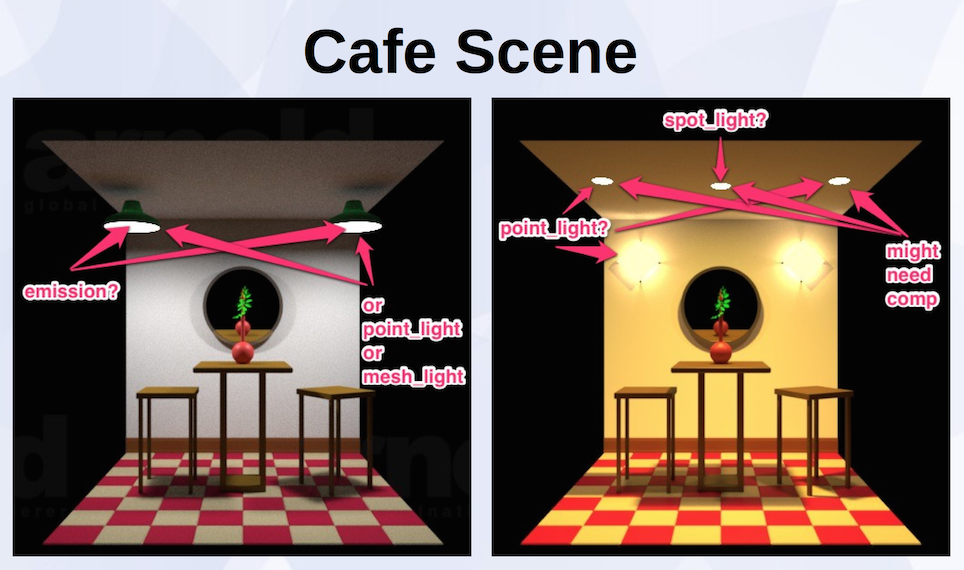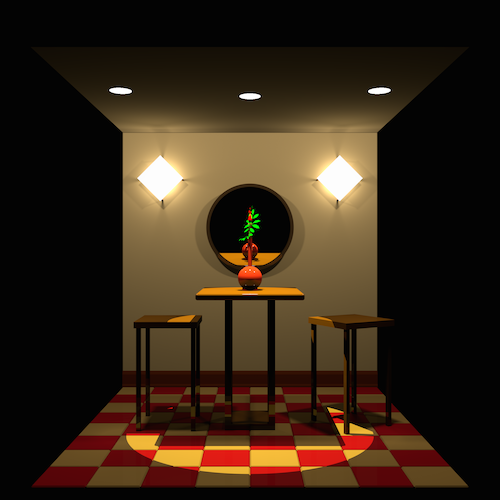
Chapter 2 of the Rendering with Radiance book introduces this Cafe Scene. It shows exacly the same geometry lit by two different light setups.
On the left two light emitting spheres (light bulbs) are covered by lamp shades, so that most of the light will be shed downwards and only a bit of light bounces around and illuminates the upper part of the back wall and the ceiling.
On the right you see an alternative in lighting using using the three basic approaches to interior lighting design: light to look at (decorative), light for objects to be seen (accent), and general lighting to see by (ambient):
-
In the original Radiance scene the middle light on the ceiling is actually a spotlight, located above the flower and the vase, providing dramatic focus to the table area.
-
The diffuse downlights will flank the table and provide a nice, airy, general illumination during the daytime. It is likely that they will be turned off at night; this will heighten the visual drama created by the spotlight.
-
The wall sconces are located above the mirror height, which keeps them out of the patrons’ reach and improves the visual composition of the scene. By rotating the sconces 45 degrees, a more interesting shadow pattern is created.
Even though this scene is still pretty simple, it raises a couple of questions.
-
Are the light emitters visible? In principle the light emitting spheres are visible in the first lighting condition (using the lamp shades). Nevertheless, if we don’t move the camera and take a single picture of the scene, we hardly can detect the spheres within the very bright reflections of the inner lamp shades. Therefore we can get away by using more traditional point lights. In Arnold a point light can even have a radius which will affect the hard- or softness of the resulting shadows. In case we potentially see the light emitting spheres we still have two choices in Arnold: We can use the emission parameters of a standard shader with some sphere primitives, or we can tesselate the spheres into meshes and use Arnold’s mesh_light. As we will see in another blog using a mesh_light has the advantage that you can tweak the samples per light emitter to further reduce the rendering time or raise the quality of the resulting images.
-
Can we tweak the rendering times by using simpler light sources? The second lighting condition would also allow to use point lights for the light emitting spheres (part of the wall sconces) because they are hidden (from this perspective) by slightly light emitting lenses. But what about the three light emitting discs on the ceiling? The middle one was supposed to act like a spotlight by “clipping” the diffuse output of the lamp into a cone. What if the renderer in question does not allow the usage of spotlights? In that case we have to model something to wrap the light emitter and clip the emitted light to a similar cone shaped beam of light. For Arnold we can drastically reduce the render time and the noise by choosing carefully alternative light emitters and tweak light and option parameters for this scene (as seen below):

- Is there a way to separate the light emitters from their shape? For example the light emitting disks at the ceiling can be replaced by spotlights with various cones to direct the light rays. But we still want to see three white disks. One solution would be to render those separately and composite them on top of the rendered image. But can we prevent this? Some renderers like Povray allow the usage of looks_like to have a visible object in the scene, but the light still comes from invisible light sources. In Arnold we could for example use an utility shader and a disk primitive parameter called visibility to tell the renderer which rays a geometry is visible to. Of course none of this would be physically correct (or even physically motivated).
...
utility
{
name MAlightring_util
color_mode 0 # color
shade_mode 2 # flat
color 100 100 100
}
disk
{
...
visibility 5 # AI_RAY_CAMERA & AI_RAY_REFLECTED
...
}
...Posts about more complex scenes (and other aspects of rendering) will follow soon …
